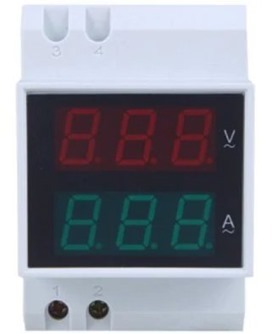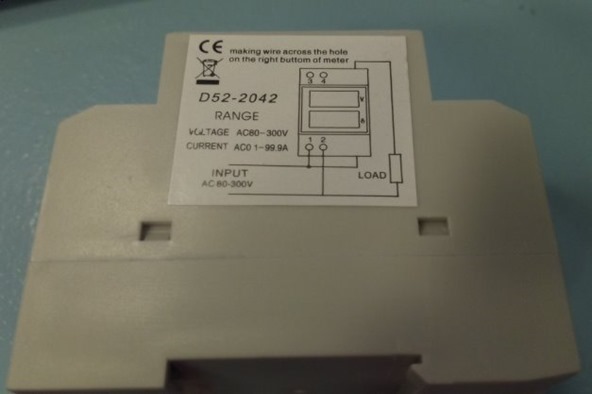 I just received one of these DIN-rail units from GearBest – and the price isn’t bad at £7.73 (sterling)… inc free shipping to the UK. https://goo.gl/aQYcqU
I just received one of these DIN-rail units from GearBest – and the price isn’t bad at £7.73 (sterling)… inc free shipping to the UK. https://goo.gl/aQYcqU
At first I could not understand how they managed with two wires. Simple really. A pair of connections take in mains power (for the meter) and you feed neutral directly to the load and the live by a suitably thick cable through a round vertical hole and off to your load (or a breaker as required). The current measurement works like a standard clamp meter using magnetic induction.
This unit measures from 80-300v and from 1-99 amps and hence could be used for measuring power to one device or the whole house depending on your house. Only tackle this it you are comfortable handling mains voltages and have suitable experience. If you blow yourself up, no responsibility accepted.
Personally I plan to use it to measure the appliances in our kitchen as I’m convinced that’s where the bulk of our power goes. Of course you don’t HAVE to mount it on a DIN rail.


official sonoff din rail mount case holder, suitable for various models:
https://www.banggood.com/SONOFF-DR-DIN-Rail-Tray-Adjustable-Mounted-Rail-Case-Holder-Solution-p-1263432.html?rmmds=collection&cur_warehouse=CN
AND, new sonoff with wifi PLUS a gsm modem: https://www.banggood.com/SONOFF-G1-16A-GPRS-Remote-Control-Switch-GSM-Mobile-Phone-App-Remote-Controller-Module-p-1153460.html?rmmds=collection&cur_warehouse=CN
About time they did something new. I do wish they would put 4MB in Sonoff basic.
you should try the SHELLY, too… but are more expensive… ah, with latest firmware they have native LOCAL mqtt support, no need to reflash them to bypass their cloud, which is optional…
I watched that youtube video. I really don’t like the idea of the ‘hot’ or live connection on the Io pins.
Nice compact design but still it won’t fit into a standard depth UK switch box.
SDM630-Modbus for 3 phase or SDM120-Modbus for 1 phase are more expensive but more useful. It works with raspberry pi or esp8266 (Tasmota)
how to use it with Node-Red, video by Csongor Varga: https://www.youtube.com/watch?v=yBtqKSWDn1Q
As you say more expensive – i.e. nearly 3 times the price. Personally at that level I’d be happier with WIFI or Bluetooth than modbus.. but that’s just me.
but it’s useful only for immediate verification, no historical log… if something is consuming power while you’re sleeping, you’ll never know…
take a look at the PZEM-004 and 004T, one is boxed and with displays, the other is naked… they use toroids and are very safe and reliable, from the reviews… easy integratable in nodered, as they use a serial protocol…
https://www.youtube.com/watch?v=qt32YT_1oH8
Of course. Somewhat more expensive and definitely more DIY however. The board you’ve included the link to, Aidan and I discusssed yesterday and he’s ordered one. All good stuff.
Do you know a similar solution but with a DC IN ?